- Joined
- Jul 23, 2015
- Messages
- 17,829
I was fortunate enough to recently acquire a used Spyderco Emphasis at a good price, and liked it from the get go, with a few caveats, namely stiff action, and teflon weashers, which I will touch on further down. So I decided to customized it to my own preferences. Pics below.
But before I detail my work, let me say the knife is a beautiful design, cuts well enough, and was one of the few Spyderco G10 handled knives on which I did not feel the need to further chamfer the edges of the scales as they were already quite comfortable. I will never complain about Spyderco's 8Cr13MoV, as it is a totally underrated steel with fantastic toughness, which takes a supremely fine edge, and has always proven itself to be more than adequate at resisting corrosion in my environments.
The changes I did make are as follows:
I replaced the teflon washers with bronze washers from a cheap Milwaukee knife from Home Depot (which I hand rubbed against a few grits of diamond plates to bring their thickness down to the right level). I did this because the teflon washers were wearing incredibly fast and with another hundred openings and closings or less they would have been consumed beyond their usefulness. The choice of using teflon washers in this knife, at least in the one I received, seems questionable. The action was much too stiff, and the washers were getting destroyed.
I removed the finger choil and lengthened the usable edge length, bringing the plunge grind all the way back to the scales.
I created a new "finger choil" by grinding down the underside of the front of the scales, and though it does not allow choking up quite as far, I feel I can still do so safely and far enough to make use of the point with greater precision, as well as get my hand right up to the cutting edge for maximum leverage in hard cuts.
I hand filed a detent ramp, as I am wont to do on all my liner locking knives.
I opened up the finger groove in the handle some to allow better access to the opening hole. I also slightly reshaped the front of scales for aesthetics.
And I reground the whole blade to be around .0012" behind the edge.
All in all, I like this knife design as it comes from the factory, except for the teflon washers, and I love it three times as much with the changes I have made.
It is like a larger handled budget Sliverax for me now.
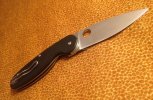
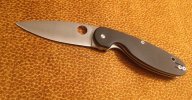

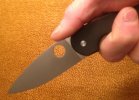
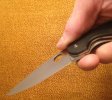
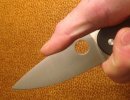
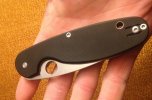
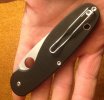
But before I detail my work, let me say the knife is a beautiful design, cuts well enough, and was one of the few Spyderco G10 handled knives on which I did not feel the need to further chamfer the edges of the scales as they were already quite comfortable. I will never complain about Spyderco's 8Cr13MoV, as it is a totally underrated steel with fantastic toughness, which takes a supremely fine edge, and has always proven itself to be more than adequate at resisting corrosion in my environments.
The changes I did make are as follows:
I replaced the teflon washers with bronze washers from a cheap Milwaukee knife from Home Depot (which I hand rubbed against a few grits of diamond plates to bring their thickness down to the right level). I did this because the teflon washers were wearing incredibly fast and with another hundred openings and closings or less they would have been consumed beyond their usefulness. The choice of using teflon washers in this knife, at least in the one I received, seems questionable. The action was much too stiff, and the washers were getting destroyed.
I removed the finger choil and lengthened the usable edge length, bringing the plunge grind all the way back to the scales.
I created a new "finger choil" by grinding down the underside of the front of the scales, and though it does not allow choking up quite as far, I feel I can still do so safely and far enough to make use of the point with greater precision, as well as get my hand right up to the cutting edge for maximum leverage in hard cuts.
I hand filed a detent ramp, as I am wont to do on all my liner locking knives.
I opened up the finger groove in the handle some to allow better access to the opening hole. I also slightly reshaped the front of scales for aesthetics.
And I reground the whole blade to be around .0012" behind the edge.
All in all, I like this knife design as it comes from the factory, except for the teflon washers, and I love it three times as much with the changes I have made.
It is like a larger handled budget Sliverax for me now.









